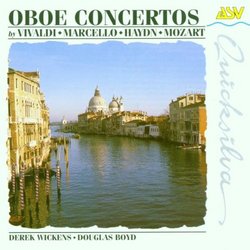| All Artists: Vivaldi, Marcello, Haydn, Mozart Title: Oboe Concertos Members Wishing: 0 Total Copies: 0 Label: Asv Living Era Release Date: 4/23/1996 Genre: Classical Styles: Forms & Genres, Concertos, Historical Periods, Baroque (c.1600-1750), Classical (c.1770-1830), Instruments, Reeds & Winds Number of Discs: 1 SwapaCD Credits: 1 UPC: 743625617429 |
Search - Vivaldi, Marcello, Haydn :: Oboe Concertos
 | Vivaldi, Marcello, Haydn Oboe Concertos Genre: Classical
|
Larger Image |
CD Details |
CD ReviewsExcellent Background into Oboe Usage in 18th Century rodboomboom | Dearborn, Michigan United States | 05/24/2001 (5 out of 5 stars) "Line notes are very informative. Didn't know that oboe didn't come into formal usage as we know of it until mid-17th Century in France. No wonder that country still produces best of this instrument.Thus, here we have four concertos for oboe and orchestra from 17th C, two from beginning and two towards the end. Learned that Vivaldi wrote 11 concertos for oboe plus two more for oboe and orchestra. The one on this recording is from 1716 and features in the third movement ample rythm for the wonderful solo work which are framed by the tuttis.Although introduced to Marcello here and fascinated to learn that Bach transcripted much of his harpsichord pieces for Duke Ernst at Weimar. Intense oboe piece of melancholy and stillness.Haydn's Concerto in C is under dispute it seems for his composition, but as notes state: "would by no means be displeased with its subsequent attribution to him." Ending Rondo is excellent.Interesting that Mozart's Oboe Concerto in C was not discovered until 1949, since for years it was under the form of his Concerto in D major for flute, which he had transposed it. Originally written for Fereiendi, principal oboeist at Salzburg Orchestra, it is light and charming, with very bright finale." Oboe: The Seductress of the Orchestra 01/21/2000 (5 out of 5 stars) "If there is a more sensual, emotional instrument, I have never heard it. These pieces bring to life the wonderful tone and complexion of the oboe, and show off the amazing talent of the musician. I especially enjoy Vivaldi's third movement, Haydn's first movement, and Mozart's third movement. The uptempo pieces move delightfully up and down the scale with effortless precision, while the slower movements bring the somber mood to life."
|

 Track Listings (12) - Disc #1
Track Listings (12) - Disc #1